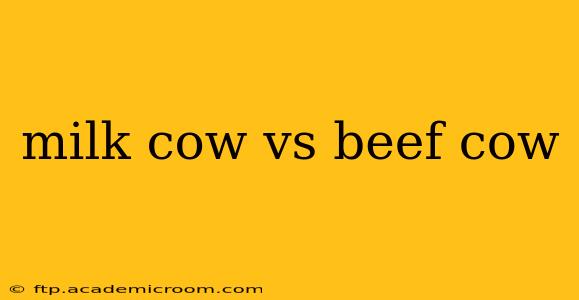Choosing between a milk cow and a beef cow depends entirely on your goals. Are you looking for a dairy source, or are you focused on raising cattle for meat? Understanding the key differences between these two types of cattle is crucial for making the right decision. This comprehensive guide will delve into the distinctions, exploring breed characteristics, production capabilities, and management considerations.
What are the main differences between milk cows and beef cows?
The most significant difference lies in their primary purpose. Milk cows, also known as dairy cows, are selectively bred for their high milk production. Beef cows, on the other hand, are raised primarily for meat production. This fundamental difference leads to variations in their physical characteristics, genetics, and overall management.
What are the physical differences between milk cows and beef cows?
Milk cows typically have a leaner build compared to beef cows. Their bodies are designed for efficiency in converting feed into milk. Beef cows, conversely, are often larger and heavier, with a more muscular physique that contributes to higher meat yield. You'll notice differences in udder size, too; dairy cows boast significantly larger udders to accommodate their substantial milk production.
What breeds of cows are best for milk production?
Several breeds excel in milk production. Holstein Friesians are arguably the most popular, renowned for their high milk volume and relatively efficient feed conversion. Other high-yielding breeds include Jersey, Guernsey, and Ayrshire cows, each with slightly different milk composition and production characteristics. The best breed for you depends on factors such as climate, available feed, and desired milk composition.
What breeds of cows are best for beef production?
Beef cattle breeds are selected for their muscle growth, carcass quality, and overall feed efficiency. Angus, Hereford, and Charolais are among the most popular beef breeds, prized for their marbling, meat quality, and adaptability to various environments. Breed selection for beef production often considers factors like climate resilience, growth rate, and the desired carcass characteristics.
How much milk does a milk cow produce?
The milk production of a dairy cow varies greatly depending on breed, age, genetics, nutrition, and overall management. High-producing Holstein Friesians can yield upwards of 25,000 kilograms of milk per lactation, while other breeds produce less. It's essential to consider these factors when evaluating the potential yield of your dairy cow.
How much meat does a beef cow produce?
The amount of meat a beef cow produces depends on factors like breed, age, diet, and genetics. A well-fed, mature beef cow can yield a substantial amount of meat, contributing significantly to the overall profitability of beef farming. Factors such as carcass weight and marbling significantly influence the value of the meat produced.
Are there any crossbred cows that combine milk and meat production?
While no breed perfectly balances both high milk yield and high meat production, some crossbreeds offer a compromise. These dual-purpose cows may not reach the peak production levels of specialized dairy or beef breeds but can provide a valuable source of both milk and meat, particularly in smaller-scale farming operations. Careful selection of parent breeds is crucial to maximize the benefits of this approach.
What are the costs associated with raising each type of cow?
Raising both milk and beef cows requires significant investment. Factors such as feed costs, veterinary care, housing, and labor significantly impact the overall expense. Dairy cows typically demand higher feed costs due to their higher energy requirements for milk production. Beef cattle production involves longer timeframes and requires investments in pasture management and potentially feedlot operations. A detailed cost-benefit analysis is essential before committing to either type of cattle raising.
This comparison provides a foundational understanding of the differences between milk cows and beef cows. Remember that the optimal choice depends heavily on your individual circumstances, goals, and resources. Further research tailored to your specific needs will enhance your decision-making process.
